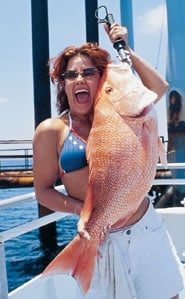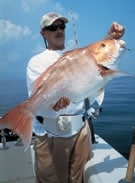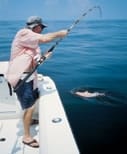
| Kipi Holcomb hoists a hefty snapper on a rig trip with Captain Elliott’s Party Boats out of Freeport, Texas. To hook a snapper of this size, you don’t need to run far in spring. |
Lucky Gulf Coast anglers have their calendars marked for April 22, when federal waters in the Gulf of Mexico open to recreational red snapper fishing. And they have plenty to be excited about, because April and May are two of the best months to find big snapper holding close to rocks, wrecks and rigs located anywhere from 25 to 35 miles out. Why is the fishing so good at this time of year? Two reasons: lack of fishing pressure and water temperatures in the 65- to 70-degree range.
No one knows this better than John Blackwell of Beaumont, Texas, one of the most experienced and respected snapper fishermen on the Gulf Coast. No wonder that April and May are two of his favorite months. His 35-foot Cabo, Hasta La Vista, is powered by twin 435-horsepower turbo Caterpillars, making it one of the fastest boats on the coast, and for good reason – he likes to get to the action in a hurry. Blackwell also doesn’t like to be followed, which is a problem when you know a lot of hot numbers to some of the best snapper spots in the Gulf.
“During the spring, I’m usually fishing 30 to 35 miles off Galveston,” says Blackwell. “And I’ll be in water that’s around 50 to 60 feet deep. At that time of year you don’t need to run nearly as far as you do during the summer months.”
Structure Strategy
Blackwell likes to target the oil and gas rigs first, then hits a few wrecks. “When the season first opens in April, the rigs in 50 feet of water haven’t yet received a lot of pressure,” he explains. “Therefore, the fishing around them can be very good.”
A couple years back, I made a spring snapper run with Blackwell to a group of three rigs lying east of Galveston in 45 to 55 feet of water. Once we reached the rigs, Blackwell slowly circled the first two while studying his depthsounder.
“We’ve got some baitfish holding here, but I don’t see anything that looks like snapper,” he said. “Let’s make a run over to that other rig and see what we can find.”
Blackwell circled the third rig, then slipped the boat into reverse and backed down to within about 20 fet of the structure. “Y’all try fishing here for a minute and see what happens,” he said.
Taking up my spinning outfit, I tossed a two-ounce jig tipped with a Spanish sardine into the current swirling next to the rig legs. The jig had settled to about 20 feet when I felt a solid thump. I set the hook and the rod doubled over.

Dan Howell of Beaumont, Texas, caught this snapper while fishing a sunken workboat in 85 feet of water. The fish hit a three-ounce Snapper Slapper jig tipped with a whole pogy.|
“That’s what I thought,” Blackwell grinned. “We’re into some sow snapper here!”
An hour later we had trouble closing the lid on the fishbox. We had iced snapper up to 19 pounds, with the average fish running in the 12- to 14-pound range. That’s about as good as snapper fishing gets!
Head East, Young Man
One of the best areas to target snapper is around the Texas-Louisiana border. The offshore waters between the Sabine and Calcasieu jetties are dotted with dozens of wrecks, rigs and manmade reefs that produce some of the most consistent fishing on the Gulf Coast. Best of all, many of the shallower pieces of structure can produce excellent fishing.
One of the most popular snapper spots in this area is the Sun Rigs, located 30 miles south of the Sabine jetties and sitting in 40 to 50 feet of water. A typical spring snapper trip out of Sabine Pass involves running out to the 18-mile light, then rig- and wreck-hopping to the Sun Rigs. Later in the season, as the water temperature rises into the 80s and fishing pressure increases, those nearshore wrecks and rigs tend to hold very few snapper.
Perhaps the best thing about early-season snapper is that the fish can be found in shallow water and are relatively easy to catch. You don’t need to rig up with heavy bottom rigs; simply tie on a jig and tip it with a chunk of squid or whole baitfish, then fish it around some structure. Blackwell’s favorite shallow-water snapper offering is a two-ounce jig with a nylon tail. To sweeten the jig, he’ll place a whole Spanish sardine or pogy on the hook.
“When the snapper are holding in 50 or so feet of water, I’ll go with a two-ounce jig,” says Blackwell. “But if the current is strong, I’ll switch to three-ounce. My favorite colors are white and yellow.” Blackwell casts the jig-bait combo 15 to 20 yards from the boat and lets it sink. This allows the jig to swing back to the boat in an arc that covers the upper portion of the water column. It’s a great way to locate the fish, especially the sows.
Sow snapper – fish over ten pounds – usually hang out together. When you catch one, chances are good you’ll catch several. That’s what happened to Blackwell on his best spring run last year, which saw him ice 24 fish weighing from 18 to 22 pounds.
Use Your Sounder

Dr. Curtis Thorpe leads a snapper to boatside. April and May is prime time for snapper action at the nearshore rigs and other structure thanks to a lack of fishing pressure and cool water temperatures.|
Charter captain Tommy Pellegrin of Cocodrie, Louisiana, also specializes in catching big snapper around the oil and gas rigs in April and May. “What most people do is tie off to a rig and lower baits to bottom,” says Pellegrin. “But that’s not the best way to catch snapper on a rig. You have to remember that the fish will leave the structure to feed. That’s why I don’t ever tie off. Sure, you can catch snapper that way, but they won’t be very big.”
Pellegrin relies on his fishfinder to locate snapper, which often venture far from the rig to look for food. This strategy takes a bit more patience, but it can pay off with lots of big snapper. According to Pellegrin, when the water is very clear, the fish may feed 75 yards away from the rig. However, in murky water they will usually be 25 to 50 yards from the structure.
“During spring, I’ll fish in 80 to 100 feet of water,” adds Pellegrin. “That means I’ll be 20 to 40 miles out – a lot closer and shallower than I normally fish.”
Pellegrin fishes only whole Spanish sardines when targeting snapper. “The snapper I’m fishing for will usually be on bottom,” he says. “So naturally I’ll rig up with bottom-fishing tackle. A Carolina rig is best. I use a four- to six-ounce egg sinker rigged above a 12/0 Mustad circle hook. If the current is light, a four-ounce weight is best, but in strong current I may need a six-ounce weight to reach bottom.”
Pellegrin spools his reels with 50-pound line, which is ideal for targeting big snapper around the rugged wrecks and rigs. You can get away with using 30- to 40-pound test, but 50 gives you a little more security.
Naturally, a leader is mandatory. I prefer 80-pound-test fluorocarbon, which I connect to the main line via an Albright knot. The length of the leader can range from three to six feet, but I feel that longer is better. The Albright knot can be reeled through the rod guides, and the long leader can be hand-wrapped to maneuver a big snapper to the net or gaff.
| ## Snapper CaptainsCapt. Tommy Pellegrin Cocodrie, LA (985) 851-3304Charlie Hardison & Sons Charters Port Fourchon, LA (888) 463-4747 www.hardisonoffshorefishing.comCapt. Elliott’s Party Boats Freeport, TX (979) 233-1811 www.deep-sea-fishing.comCapt. Kyle Engelhardt Galveston/Freeport, TX (832) 630-4342Williams Party BoatsGalveston, TX (409) 762-8808 |
When it comes to natural baits, always make sure they’re are as fresh as possible. The best baits should be firm and remain half frozen when placed on the hook. Never leave them exposed to sunlight or the’ll soften.
Killer Jigs
Snapper can be taken on all kinds of jigs, but the one that has really taken the snapper-fishing fraternity by storm is the Snapper Slapper (www.snapperslapperlures.com). Woody Woodward, who helped design these jigs, recommends the three-ounce version for shallow water. In water over 100 feet deep or in strong current, a five-ounce jig is best. “You’ve got to stay in contact with the jig,” advises Woodward. “You don’t want the current sweeping it away from the feeding snapper.” Woodward says that the best color combination for snapper is red-and-white, although white or pink work well too.
Try Some Chum
Captain Kyle Engelhardt has been guiding anglers to snapper for about 20 years out of Galveston and Freeport, Texas. He’s into chumming up snapper during the spring and catching them on 1 1/2- to two-ounce jigs.
“I usually fish from 25 to 30 miles out, and concentrate on hard spots,” says Engelhardt. “These are lumps of rock and coral that attract baitfish and bring in the snapper. They don’t get nearly as much pressure as the rigs do. Even though the water depth is around 100 feet, we find most of our big snapper holding anywhere from 30 to 50 feet below the surface. When you get them in the chum, it’s exciting fishing.”
Not all snapper will be found in shallow water during the spring. Captain David Harrelson of Charlie Hardison & Sons Charters in Port Fourchon, Louisiana, targets snapper in water ranging from 120 to 240 feet deep during the spring. Deep water lies relatively close to Fourchon, and this is where the all-tackle world-record red snapper of 50 pounds, four ounces was taken by Doc Kennedy in 1996. He caught that monster on a whole mackerel near a rig – and he was fishing with Hardison & Sons.
Harrelson targets giant snapper around the deep-water rigs and wrecks. He rigs up with a three- to four-foot leader, an eight- to ten-ounce sinker and a 12/0 circle hook. The sinker is rigged at the bottom of the leader, while the hook is tied in about halfway up the leader. Preferred baits are squid, pogies and mackerel. “That’s the best deep-water rig you can use,” says Harrelson. “It’s caught some really big snapper.”
If you would like to catch some really big snapper without having to run 100 miles, now’s the best time to do it. So dust off your gear, fire up the engines and set a course for some nearshore structure. The fish will be waiting.
| ## Baiting the BottomWhen it comes to targeting big spring snapper around the oil and gas rigs off Cocodrie, Louisiana, Captain Tommy Pellegrin prefers bottom-fishing gear. After using his depthsounder to locate the snapper, which often roam up to 75 yards away from the structure, Pellegrin sends down a whole Spanish sardine on a standard Carolina rig.”I use an egg sinker rigged above a 12/0 circle hook,” he explains. “If the current is light, a four-ounce weight is best. But in strong current, I may need six ounces to reach bottom.”A Carolina rig works well on big, wily snapper because it allows the fish to move off with the bait without feeling resistance from the sinker. A fixed sinker might cause the fish to drop the bait when it feels resistance.The great thing about using circle hooks in this type of rig is that the fish is less likely to be hooked in the stomach, throat or gills if given a lot of time to eat the bait. The design of the hook allows it to slide out of the fish’s mouth and catch in the jaw. For circle hooks to work, however, you must remember not to set the hook by jerking back on the rod. Instead, simply lower the rod and reel until the fish begins taking line against the drag.### The Carolina Rig |

|









